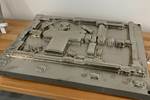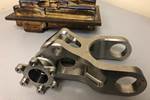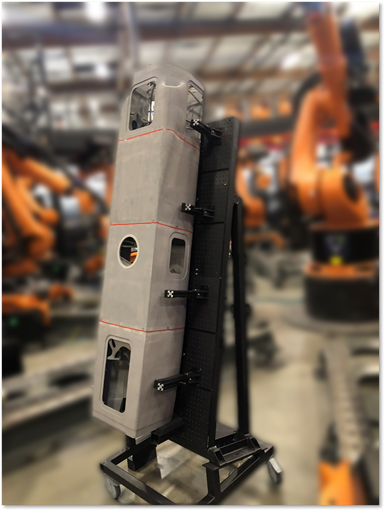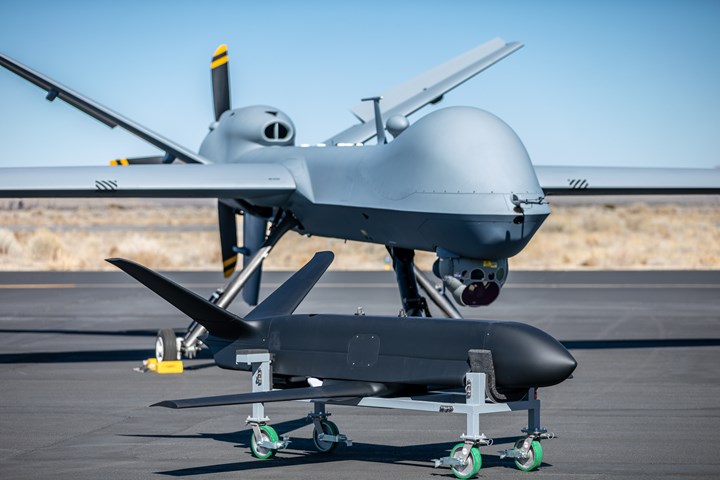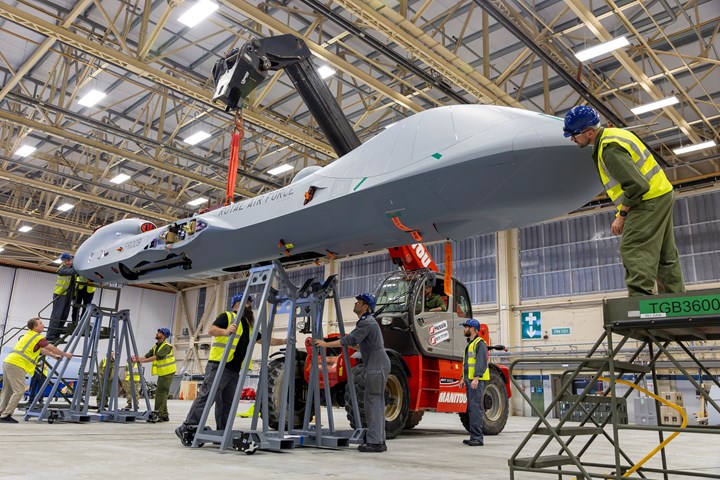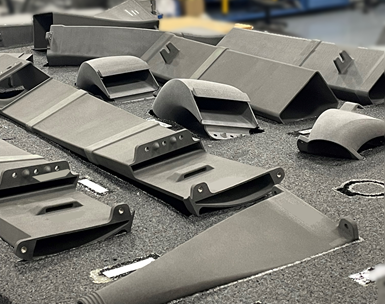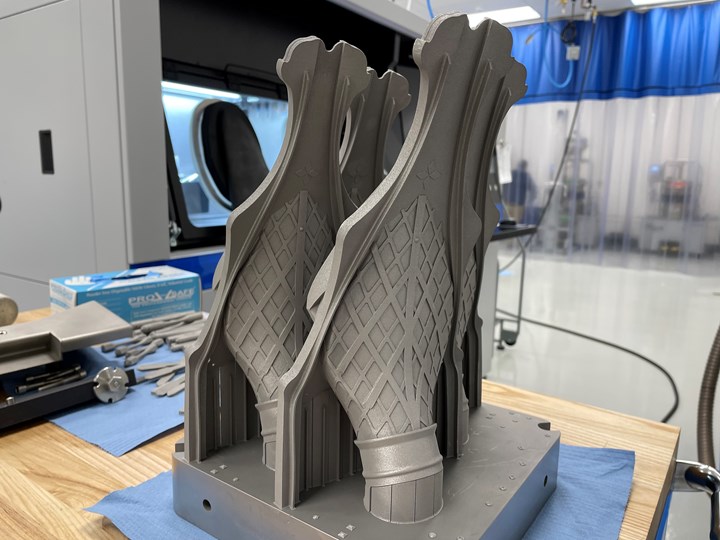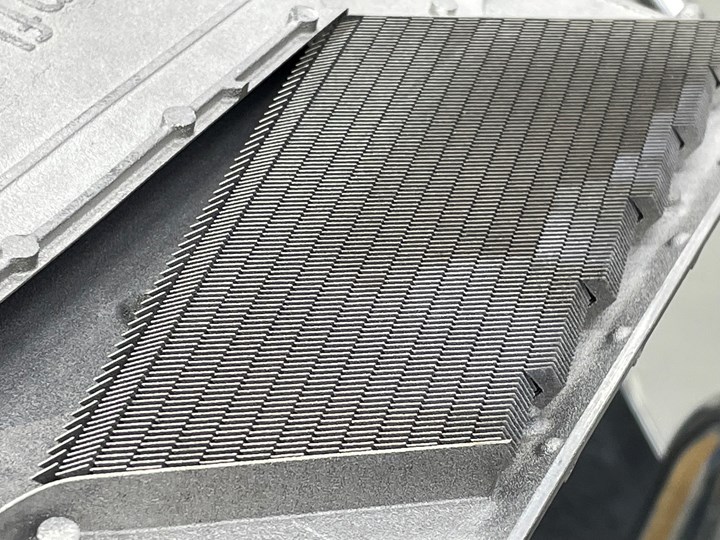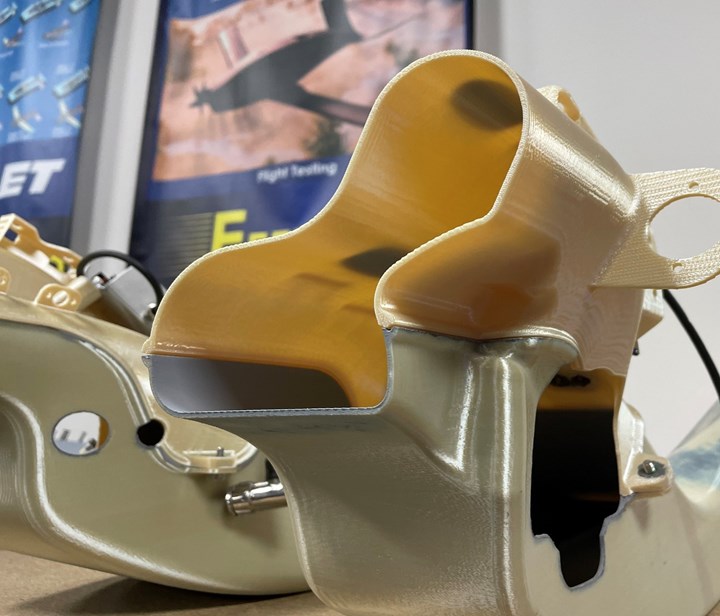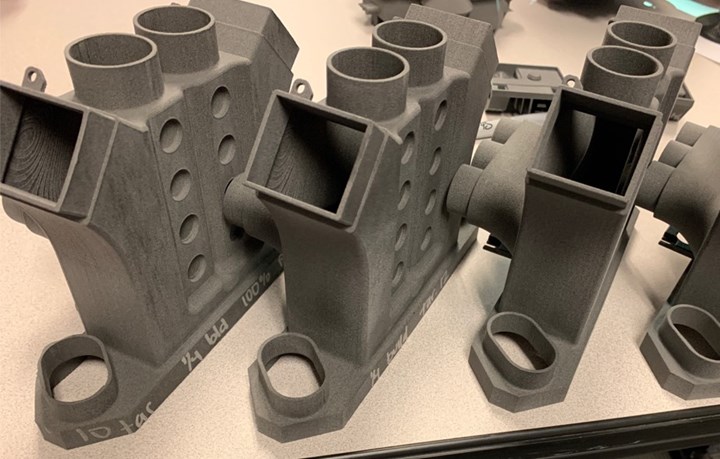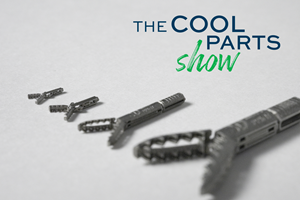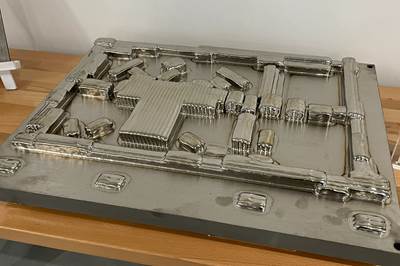In news reports from the previous decade related to U.S. counterterrorism activities, a phrase that was often heard was “Predator drone.” The term is not accurate — a drone is a simpler device — but the popular reference is a useful starting point to understand the product being made at the General Atomics Aeronautical Systems Inc. (GA-ASI) facility in Poway, California. The plant here is dedicated to making unmanned aerial systems (UASs) or in a phrase used by the U.S. military, remotely piloted aircraft. These are flying systems the size of small airplanes that can be used for surveillance and other tasks without carrying a human pilot. The “Predator” became famous for counterterrorism. Today, a more sophisticated version of the craft goes by the name “SkyGuardian” or “SeaGuardian,” its roles have expanded, and the production of these craft makes extensive use of additive manufacturing.
The 8-foot-long body of the small UAS (see next photo) is made of four 3D printed nodes that replace what otherwise would have been 180 parts. All photos in this article courtesy of General Atomics.
Indeed, to walk across the Poway production floor is to see a glimpse of the future. I got to take this walk in the company of Steve Fournier, GA-ASI senior manager of the company’s Additive Design and Manufacturing Center of Excellence (more on that in a bit). AM is taking its place as an option for part production for many manufacturers, but for General Atomics, AM has found this place. In Poway, where parts are staged all along the production floor for aircraft assembly, it was easy for Fournier during our walk to pick out the ones that had been 3D printed. “This cable pass-through, that avionics spacer, this sealing trim, those air inlets….,” he said, pointing in rapid succession to various additive parts he spotted. Additive manufacturing is now responsible for various components of existing aircraft, and it is set to radically reshape the design and production of craft to be released soon (more on that in a bit as well). For GA-ASI, additive manufacturing has arrived as a production process.
And getting here has been the result of inherent advantages the company possesses combined with commitments the company has made to developing AM.
The SkyGuardian is an unmanned aerial system the size of a piloted aircraft. The forthcoming small UAS can be carried by the larger craft, extending its capabilities and mission.
The advantages first. UAS manufacturing is inherently low-volume, high-mix production — the kind of production for which AM is most likely to offer a strong business case. UASs such as the SkyGuardian are made in relatively low quantities (50 to 250 per year) and are extensively tailored to the needs of the buyer. In addition, GA-ASI (hereafter, GA) has a highly vertically integrated production operation. Almost every step needed to produce a plane is performed to some extent at the Poway campus or near it elsewhere in California, and a breadth of major components are produced at Poway exclusively. (For example, a production area staffed by over 100 team members is dedicated to making cables.) Vertical integration helps additive succeed, because it means the engineering, manufacturing, quality and logistics stakeholders whose efforts are transformed by components and subsystems being reconceived for additive are all in one place and can interact easily. Finally, GA has historically made an aircraft with no passengers, and one meant for uncontested airspaces. This has opened the way for the company to integrate novel AM components into its designs, with no human safety need necessitating the more extensive analysis and certification that other aircraft parts require. The result: GA has now accumulated over 300,000 flight hours with AM components. More recently, successful certification of the SkyGuardian for controlled airspace in Europe has come with increased airworthiness requirements, but the performance track record of additive parts aids in assuring their reliability and compliance.
Here is a SkyGuardian being delivered to its customer destination, where the last steps of assembly occur. The recipient here is the UK Royal Air Force, which refers to the aircraft as the Protector.
Those are the advantages. Here is how GA has used them: The company had been applying AM for years, but it recognized about six years ago that additive would be a vital capability for the future of its production — to the extent that GA would have to master the capability and take control of its use of it. The company committed to building its Additive Design and Manufacturing Center of Excellence in Poway, which opened in 2021. That facility today makes production parts, as well as tooling and shop aids in use throughout the company, on resources that include multiple machines apiece for laser powder bed fusion (GE Additive), selective laser sintering (3D Systems and EOS) and fused deposition modeling (Stratasys).
But just as importantly, says Fournier, the company devoted people to this capability. “The AM Center of Excellence is not just for additive equipment, it’s a place for us to dedicate additive staff, to use and grow their expertise,” he says. Team members here have been both recruited and developed internally on the strength of what GA plans to be a long-term commitment to AM.
From the production floor in Poway, here is a close-up of a selection of 3D printed parts awaiting assembly into an aircraft.
Yet it’s a commitment already delivering significant impact. The various SkyGuardian craft I saw in assembly each have many additive parts, but still fewer than 1 percent of their part numbers are made this way. Even so, just that amount of additive has delivered over $300,000 per aircraft from assembly consolidation, process simplification and other part-related savings, as well as over $3 million in tooling savings for SkyGuardian production overall. And for a smaller UAS that this larger UAS will carry and deploy, additive manufacturing is poised to deliver dramatic assembly consolidation. Here, AM will replace what would have been 180 parts with four, and along the way, AM is bringing fundamental changes to the design approach that extend to a different choice of material for the outer surface of the plane.
The Inflection Point for Additive Production
Like many companies, General Atomics began its application of additive with tooling and shop aids used internally. This application was widespread because of how vertically integrated the company is, and therefore how much work it does internally. (A supplier to the U.S. Department of Defense, GA is best able to ensure U.S. manufacturing by performing work itself.) 3D printed shop floor aids such as custom jigs, trays and clamps tailored to specific needs have proven particularly useful throughout assembly operations, and this use remains an active area of innovation.
The inflection point for AM production came in 2018. Design and performance requirements of the SkyGuardian necessitated the introduction of various components that would have been expensive to produce using established methods, particularly composite lamination. An initial AM team was established; it was able to advance various polymer AM parts. However, an important milestone was the SkyGuardian designers’ determination that a particular engine air inlet that would otherwise be polymer composite had to be titanium instead. The decision came too late to obtain the tooling for the complex form without introducing significant delay. Laser powder bed fusion was the answer, and this became the first end-use metal AM component GA introduced to one of its aircraft. A lot became clearer at this point.
“We knew we had to develop this for production. We knew we needed to create an AM team to make this a production technology,” Fournier says. Shop floor aids are often one-off prints; production is obviously different. “We had to go from knowing how to do it once to knowing how to do it the same way 100 times.”
That quantity, 100, is significant. Just over 1,000 Predator-series UASs have ever been produced, even though, per GA, there are 50 Predators flying at any given moment. Fournier says, “We don’t make 10,000 of anything.” The UAS is a technology that has brought significant disruption and new possibility to aviation, even though its numerical units are small. Its impact on aviation is thus like additive’s on manufacturing.
Capabilities of the Additive Design and Manufacturing Center of Excellence include laser powder bed fusion, selective laser sintering and fused deposition modeling. Close relationships with suppliers provide access to AM capabilities beyond these, and the aim is that ultimately 80% of additive parts will come from suppliers.
The inflection point led to the commitment that led to the AM Center of Excellence. Previously 3D printing experts were dispersed throughout the company and only occasionally in contact with one another. Now the capability and the expertise would be concentrated, as well as increased — and for the benefit of not just GA-ASI but all of GA’s businesses. The staff of this center now consists of 15 people in manufacturing engineering and applications development who are devoted to AM full-time.
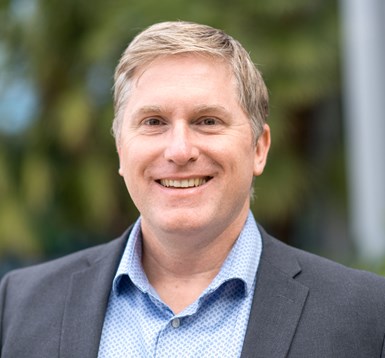
Steve Fournier, senior manager of the AM Center of Excellence, hosted me at the Poway facility. A philosophy for AM's application that he cited repeatedly is, “3D print because we should, not because we can.” Read other insights and observations from Fournier on succeeding with additive in a companion article.
“We can’t have them part time,” Fournier says. “We can’t have them splitting their responsibilities with other modes of production, because we need strategic thinking that is focused on additive.”
That thinking will guide part production well beyond this site. Even though vertical integration means there is significant manufacturing capacity (additive and otherwise) within the Poway campus, most of the AM capacity that GA will ultimately draw on will be with suppliers. The company’s expectation is that 80% of its additive parts will be outsourced, with the remaining 20% made internally. That is about the same proportion of outsource/insource it has with CNC machined parts. Directed energy deposition (DED), for example — an emerging capability for GA — will be performed outside. Notably, DED parts will be provided by Norsk Titanium, a manufacturing supplier leveraging a proprietary DED process it engineered for scale production. But for AM in general, the Center of Excellence team is tasked with producing the metal and polymer 3D printed parts that, for one reason or another, are the most challenging to send to a supplier — then supporting the outsource work with technical data packages, process and application development, and risk analysis and mitigation. The team is “not tasked to be the muscles of AM, but to be the brains of AM,” Fournier says.
In this capacity, the team either performs or supports additive production that currently sums to about 7,500 3D printed production parts per year across 340 SKUs in laser powder bed fusion, fused deposition modeling and selective laser sintering. Parts made this way (in addition to the ones we happened to see on the factory walk) include conformal structures, covers and panels with complex geometry needs, ducting, fluid manifolds, heat exchangers and cold plates. More than overseeing production of these parts, the team has also overseen a progression in the parts made this way. In fact, they’ve seen multiple progressions.
For example, in the short time GA has relied on AM for production, the role and value of additive have advanced. Its use has gone from part replacement, meaning an additive version of an existing part, to part consolidation, replacing an assembly. And it is about to make its next advance: AM as a way to realize a complete system, with GA’s forthcoming small UAS (below).
At the same time, AM has also advanced in criticality. The first metal 3D printed production part, the engine air inlet, is a class C component. The aircraft and its mission are not seriously compromised if this part fails. More recently introduced AM parts have been class B. A 3D printed nosecone is an example — this is a more critical part, but the plane can land without it. And AM is about to make its advance to class A parts. Two examples are a wing splice made via DED, and a laser powder bed fusion heat exchanger for engine cooling. These parts have the highest criticality because the plane will stop flying if they fail, but additive has demonstrated its fitness for producing these parts as well.
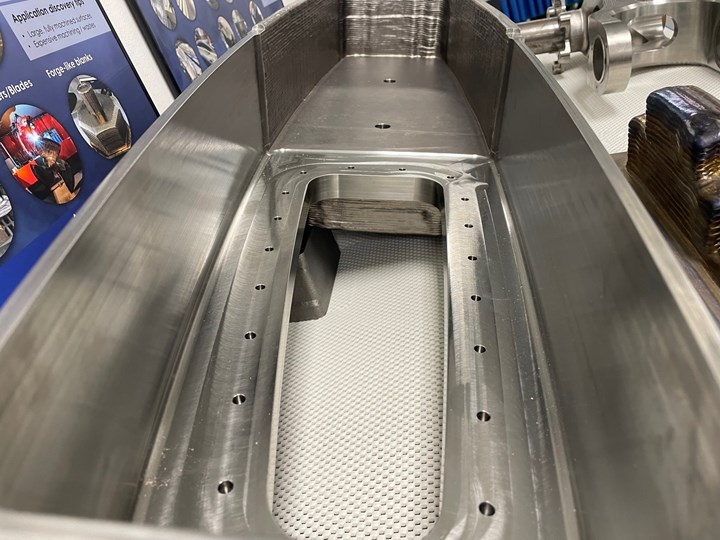
This wing splice was produced through DED by Norsk Titanium. In my report from my visit to Norsk, see a photo of the as-printed version of this part prior to any machining.
A final progression is in the amount of AM content. The potential is greater than 340 SKUs. Fournier says already-identified additive opportunities could make the AM content of each large aircraft “two to three times as much as it is today,” except that, for many of these parts, due to their criticality or material requirements, “the ecosystem is not yet there.” Production calls for more than just a demonstrated process for making the needed item, he notes; the ecosystem must include materials allowables, qualification methodology, a qualified supply chain, production-ready hardware, and more. The identified opportunity is the first step toward mapping this ecosystem or building it. Making the SkyGuardian landing gear through DED to save on assembly and material use is an example, a change that is coming.
And as for the forthcoming UAS concept that (literally) will go beyond the SkyGuardian, the amount of AM content is considerable. A GA-ASI small UAS (sUAS) currently under development is a craft able to detach from the SkyGuardian’s wing. This plane easily has the most additive content of any aircraft GA has produced, upwards of 75% by part count. It offers a picture of how far additive might go in the production of remote aircraft, and therefore offers a picture of how far AM might go in the production of aircraft in general.
Why the sUAS Can Be Made in One Day
The sUAS is carried by the SkyGuardian and expands the SkyGuardian’s uses. Launching from underwing, it fulfills missions subordinate to the larger craft. The small plane was designed to take full advantage of additive manufacturing and one result is a fundamentally new concept in aircraft structure. The 8-foot-long body of the aircraft is made of essentially four large nodes, all different, all 3D printed in aluminum via laser powder bed fusion. The four 2-foot-cube nodes consist of one node apiece for a fuel tank and cable routing; another fuel tank and wing connection; engine mounts; and payload. These four nodes replace what otherwise would have been about 180 parts to build a comparable structure conventionally.
These components are sourced from AM contract production specialist Divergent, and developed in partnership with this company. Divergent employs a proprietary hardware and software system that leverages AM for scale production of complex structures. Within this company’s Divergent Adaptive Production System, each 2-foot node is 3D printed in less than 13 hours. Fournier says the result has been a 60% savings in development time for the plane, because the fast 3D printing made it possible to iterate quickly, along with a 98% savings in tooling cost owing to all of the assembly that does not have to be done. An entire sUAS can be manufactured in just one day.
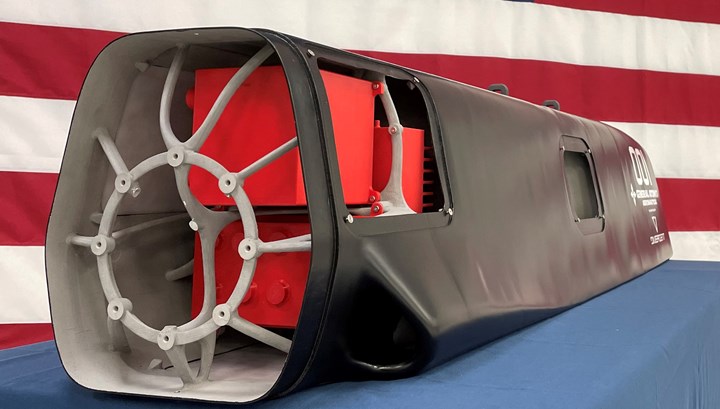
The sUAS body is made by Divergent on its Adaptive Production System. Each of the four nodes can be printed in under 13 hours. The reliance on AM allows a unitized design that in turn allows a complete aircraft to be produced in a day.
“This is an example of where additive is headed, the full progression of what it will let us do,” Fournier says. The plane represents system-level design; class A components made additively; and additive content so high that AM accounts for the majority of the plane.
Indeed, he says the embrace of AM has gone so far that, with this latest plane, AM is not the focus. The focus instead is on a fully unitized design and an automated manufacturing and assembly process that AM is uniquely equipped to enable because of the inherent geometric complexity of the part designs required. One notable win from the unitized design and simplified assembly is a streamlined design choice that is, in a way, a sort of regression. The material at the aerosurface of the plane has changed. This plane’s outer surface is aluminum, whereas modern aircraft tend to have skins made of polymer composite.
Composite skins are used for their light weight. Yet in the sUAS design, the much greater weight savings come from (A) applying material only to meet load and interface requirements of the part, via topology optimization of the 3D printed form, and (B) eliminating fasteners as part of assembly consolidation. Aluminum is heavier than composite, but eliminating parasitic mass leads to a lighter airframe overall, to the extent that fastening skins of a different material would be inconsistent with this savings. If an entire section of the aircraft body is 3D printed as one piece, then the more weight-efficient choice is to do without skins and simply allow this solid part to form the outer surface of the aircraft as well. Aluminum for the exterior is part of the history of aircraft design. And now, with additive, seemingly it will also be part of the future.
Related Content
Savage Automation Delivers 3D Printed Commercial Manufacturing Aids
The company's approach to designing end-of-arm tooling and other devices has evolved over the years to support longevity and repairs.
Read MoreAdditive Manufacturing Versus Cavitation
The design freedom possible with laser powder bed fusion (LPBF) metal 3D printing is making it faster and easier to produce complex anticavitation devices for valves.
Read MoreMicro Robot Gripper 3D Printed All at Once, No Assembly Required: The Cool Parts Show #59
Fine control over laser powder bed fusion achieves precise spacing between adjoining moving surfaces. The Cool Parts Show looks at micro 3D printing of metal for moving components made in one piece.
Read MoreBike Manufacturer Uses Additive Manufacturing to Create Lighter, More Complex, Customized Parts
Titanium bike frame manufacturer Hanglun Technology mixes precision casting with 3D printing to create bikes that offer increased speed and reduced turbulence during long-distance rides, offering a smoother, faster and more efficient cycling experience.
Read MoreRead Next
How Norsk Titanium Is Scaling Up AM Production — and Employment — in New York State
New opportunities for part production via the company’s forging-like additive process are coming from the aerospace industry as well as a different sector, the semiconductor industry.
Read More7 Lessons From General Atomics on AM for Aircraft Part Production
A manufacturing leader overseeing the way additive manufacturing is transforming unmanned aerial systems (UASs) offers observations about succeeding with 3D printing as an aircraft production process.
Read MorePostprocessing Steps and Costs for Metal 3D Printing
When your metal part is done 3D printing, you just pull it out of the machine and start using it, right? Not exactly.
Read More


